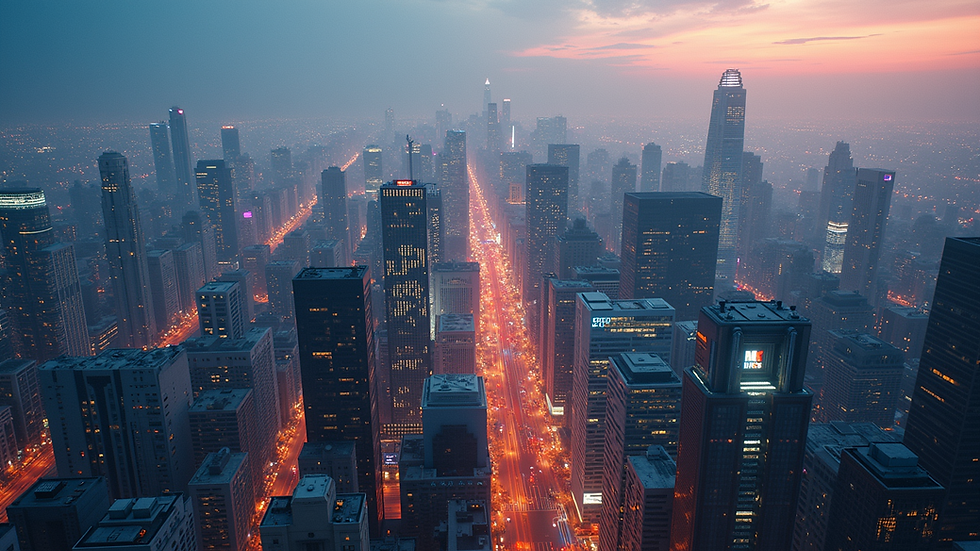The Impact of CGI Advertising on Digital Marketing
- Vinod Kumar Dubey
- Aug 10
- 4 min read
Updated: 2 days ago
The Rise of CGI Advertising
CGI advertising has surged in popularity due to technological advancements and the increasing need for eye-catching content. Research shows that 70% of consumers report they prefer content with engaging visuals. As brands strive to capture attention in a crowded market, CGI allows them to create memorable experiences that resonate deeply with viewers.
For instance, CGI can bring animated characters and breathtaking environments to life—elements that traditional methods might struggle to achieve or afford. Whether it is a vibrant cityscape or a whimsical creature, CGI offers a versatile canvas for brands looking to stand out.
Advantages of CGI Advertising
1. Enhanced Creativity and Flexibility
One of the most significant perks of CGI advertising is the endless creative possibilities it provides. Marketers can design visuals in ways that would be both challenging and costly using traditional photography. This flexibility enables brands to explore unique concepts that engage audiences effectively.
For example, brands can easily tweak CGI content to suit various platforms, ensuring creativity is not lost regardless of where it appears—be it on social media or television.
2. Cost-Effectiveness
While CGI may seem like a hefty initial investment, it can lead to significant savings in the long run. Traditional advertising often involves costs tied to location rentals, talent fees, and extensive production processes. CGI eliminates many of these expenses since visuals can be created in controlled environments.
Furthermore, once CGI assets are created, they can be repurposed for various campaigns. For instance, a single CGI character can be featured in different ads, maximizing its use and minimizing new production costs.
3. Increased Engagement and Shareability
CGI ads have an exceptional ability to draw attention and spark emotions, making them more shareable. In a landscape filled with content, engaging visuals can cut through the clutter. According to recent studies, CGI content can increase social media shares by up to 120%.
The imaginative aspect of CGI can also encourage user-generated content. For example, a captivating CGI campaign can inspire consumers to create their own content around the brand, further increasing its visibility.
4. Improved Brand Storytelling
CGI enables brands to tell their stories creatively and compellingly. By crafting immersive experiences and detailed characters, marketers can convey complex ideas that traditional methods may struggle to express. This approach typically leads to a more profound connection between the brand and its consumers, fostering brand loyalty.
5. Accessibility and Inclusivity
CGI advertising promotes inclusivity by showcasing diverse characters and scenarios that resonate with various audiences. For example, campaigns featuring individuals from different backgrounds can attract a wider demographic, making the content more relatable and appealing.
Top Examples of CGI Advertising
1. Nike's "The Last Game"
Nike's animated short film "The Last Game" effectively demonstrates how CGI can be used to create engaging narratives. Set in a futuristic world, the storyline features cloned soccer players developed to eliminate the risk of failure. The animation not only entertains but also delivers Nike’s core message about the importance of risk-taking.

2. Coca-Cola's "Happiness Factory"
Coca-Cola's "Happiness Factory" campaign is another remarkable example of CGI in advertising. The animated short invites viewers on a delightful journey through a Coca-Cola vending machine, where fantastical creatures craft the perfect beverage. The enchanting visuals and heartfelt story connect deeply with audiences, reinforcing the brand's message of joy.

3. Apple's "The Whole Story"
Apple’s "The Whole Story" showcases CGI's effectiveness in highlighting product features. The ad utilizes stunning visuals to narrate the capabilities of the iPhone through imaginative CGI sequences. By blending reality with CGI, Apple effectively engages viewers while communicating its brand message clearly.

The Future of CGI Advertising
The potential of CGI advertising is bound to continue expanding as technology advances. With the emergence of virtual reality (VR) and augmented reality (AR), brands will have even more opportunities to create interactive experiences that captivate consumers. Integrating CGI with these technologies will allow audiences to engage with narratives actively.
Brands that adopt CGI will also be better equipped to meet the growing expectations of a visually inclined market. The capacity to develop stunning, shareable content will be crucial for brands hoping to connect and stand out in the future.
Embracing the CGI Revolution
As we look to the future, it's clear that CGI advertising is not just a trend; it's a revolution in how brands communicate with their audiences. The integration of CGI into marketing strategies can elevate a brand's presence and enhance consumer engagement. By leveraging this powerful tool, brands can create memorable experiences that resonate deeply with their target audience.
The Power of Visual Storytelling
Visual storytelling is at the heart of effective marketing. CGI allows brands to craft narratives that are not only visually stunning but also emotionally engaging. This approach fosters a stronger connection between the brand and its consumers, leading to increased loyalty and advocacy.
Building Brand Identity with CGI
CGI can also play a crucial role in building and reinforcing brand identity. By consistently utilizing CGI elements that reflect the brand's values and personality, companies can create a cohesive and recognizable brand image. This consistency helps consumers associate specific visual styles with the brand, enhancing recall and recognition.
The Role of Data in CGI Advertising
As technology evolves, the role of data in CGI advertising becomes increasingly important. Brands can analyze consumer behavior and preferences to create tailored CGI content that resonates with their audience. This data-driven approach ensures that CGI campaigns are not only creative but also strategically aligned with consumer interests.
Final Thoughts
CGI advertising is transforming viral marketing, providing benefits that elevate brand presence and audience engagement. From enhanced creativity and cost savings to superior storytelling and inclusivity, the advantages are clear. As illustrated by the inspiring cases of Nike, Coca-Cola, and Apple, CGI has the power to engage viewers and leave lasting impressions.
Looking ahead, it is evident that CGI will play a vital role in shaping the future of advertising. By harnessing CGI's potential, brands can differentiate themselves in a competitive marketplace and strengthen their connections with audiences. This shift represents an exciting era for marketing—one where creativity knows no limits, and CGI leads the way. Embrace the transformation and let CGI tell your brand’s unique story.
In conclusion, the future of CGI advertising is bright. As brands continue to innovate and explore new possibilities, the impact of CGI on marketing will only grow. It is time for brands to embrace this powerful tool and unlock its full potential.


Comments